Make your way through the garden, choosing flowers to fit in your floral arrangements.
What Is Floriferous?
Floriferous is a card-drafting game for 1 to 4 players, ages 8 and up, and takes about 20 minutes to play. It’s currently seeking funding on Kickstarter, with a pledge level of $20 for a copy of the game. The game is simple to learn and is family-friendly, though as I’ll explain later it’s not necessarily a friendly game!
Floriferous was designed by Steve Finn and published by Pencil First Games, with illustrations by Clémentine Campardou. The solo rules were designed by Keith Matejka.
New to Kickstarter? Check out our crowdfunding primer.

Floriferous Components
Note: My review is based on a prototype copy and a Tabletop Simulator module, so it is subject to change and may not reflect final component quality. In particular, the pawns in the prototype were from The Whatnot Cabinet so they did not match the player colors (though I edited the photo above to make them a little closer).
Here’s what comes in the box:
- 60 Garden cards:
- 50 Flower cards
- 5 Arrangement cards
- 5 Sculpture cards
- 10 Bounty cards
- 21 Desire cards
- Cup of Tea card
- 4 Reference cards
- 4 Gardener pawns
- 12 Flower tokens (3 per player color)
- 26 Stone tokens
- 9 Crow Action cards (for solo game)
- Crow card (for solo game)

The crow cards weren’t included in the photo above, but are half-sized cards—more on the use of these later.
Kickstarter backers will also get the Early Spring mini-expansion, which includes 12 cards (3 per player).
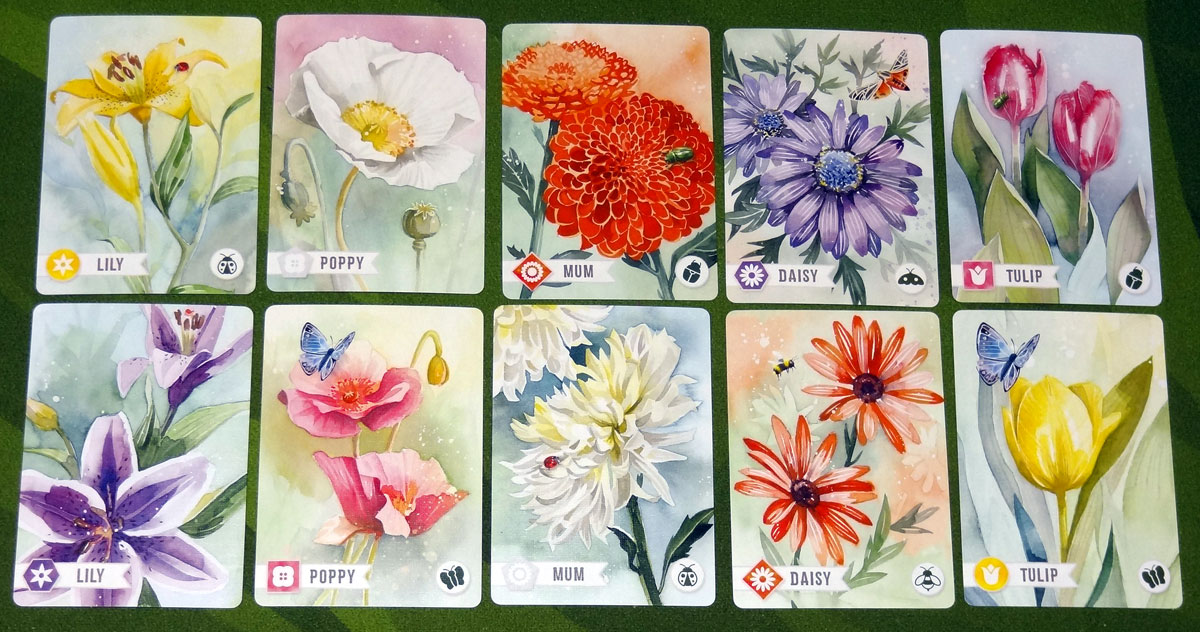
The artwork in Floriferous is by Clémentine Campardou, and it’s gorgeous. The watercolor illustrations show the five different types of flowers, and there are unique illustrations for each flower-color combination. Some of the flower cards also have insects, which are depicted on the cards as well. This is a game that I really love looking at when it’s spread out on the table, even before we get to the gameplay. The labels at the bottom of each card indicate both the flower type (by name and flower icon) and the color (by the color and shape), so they’re easily read even for color-blind players. I found the red and pink to be pretty close in some illustrations, but it’s easy to tell the diamonds from the squares.

The bounty cards look like the view of the garden fence, and each has three icons at the top indicating the items needed to complete it, along with space for players to put their flower tokens. Other than the icons, the cards are identical. I think it would have been fun to have these vary a bit based on the requirements for each card, but they work fine as is.
The stone tokens are little cardboard tokens with an illustration of a stone—they vary a little in coloration but are all equivalent. My only complaint is that since the tokens are also illustrated in the same watercolor style, they can get lost visually when placed on the cards (as you’ll see below in the setup photo).
The pawns are different colors and different shapes, again helping to distinguish them even if color is an issue. The flower tokens also have different patterns printed on them, though there is nothing (at least in the prototype) that ties a particular pawn to a particular pattern, so that may be a small issue if you can’t distinguish the colors and don’t remember which flower pattern is yours.

The player aid cards are double-sided and show the turn order, the icons for the flower cards, and the scoring reference—handy, but the text is quite small, so if you use reading glasses you’ll probably want to keep them handy. The gameplay is easy to pick up, though, so you may not need the reference cards for long.
Overall, the components are in line with some of Pencil First’s other games like Herbaceous and Sunset Over Water, with a similar compact box. Because previous campaigns had unlocked various quality improvements as stretch goals, for Floriferous the publisher is setting a goal with all of those improvements already included.
How to Play Floriferous
You can download a copy of the rulebook here. Floriferous is also available to try on Tabletop Simulator.
The Goal
The goal of the game is to score the most points at the end of three “days.”
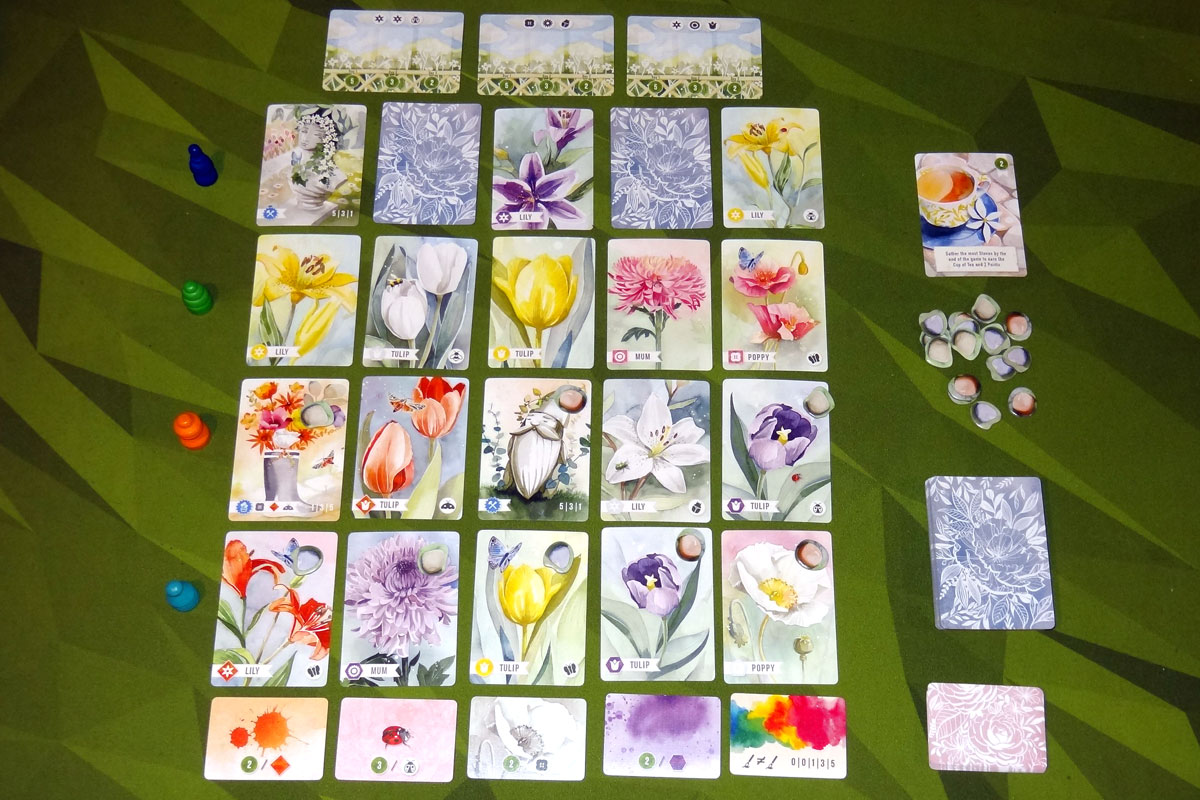
Setup
Shuffle the bounty cards and lay three across the top of the playing area, putting the rest in the box.
Shuffle the garden cards and lay out 5 columns, one row per player. The exact configuration will depend on the number of players, but the top row always has two cards turned face-down, and some rows will have stones placed on some of the cards. Shuffle the desire cards and lay out one row of cards below that. (For a 2-player game, you can also use an extended setup that has 7 columns per day instead of 5.)
Set the cup of tea card, the stones, and the two decks nearby.
Give each player a pawn and three flower tokens of their player color. Choose a random starting player, and then line up the pawns to the left of the rows, with the starting player’s pawn next to the top row.
Gameplay
Each “day” will take place over 5 rounds. Each round, players will advance one column in the garden and take a card.

The turn order is determined by the order of the pawns, from top to bottom. When it is your turn, choose one card in the next column (either a garden card or a desire card) and place it in front of you, and then move your pawn to the space where the card was. If the card was face-down, turn it face-up; if there was a stone on the card, take the stone and keep it in your area as well.
This progresses until all players have taken 5 cards, reaching the last column, ending the day.
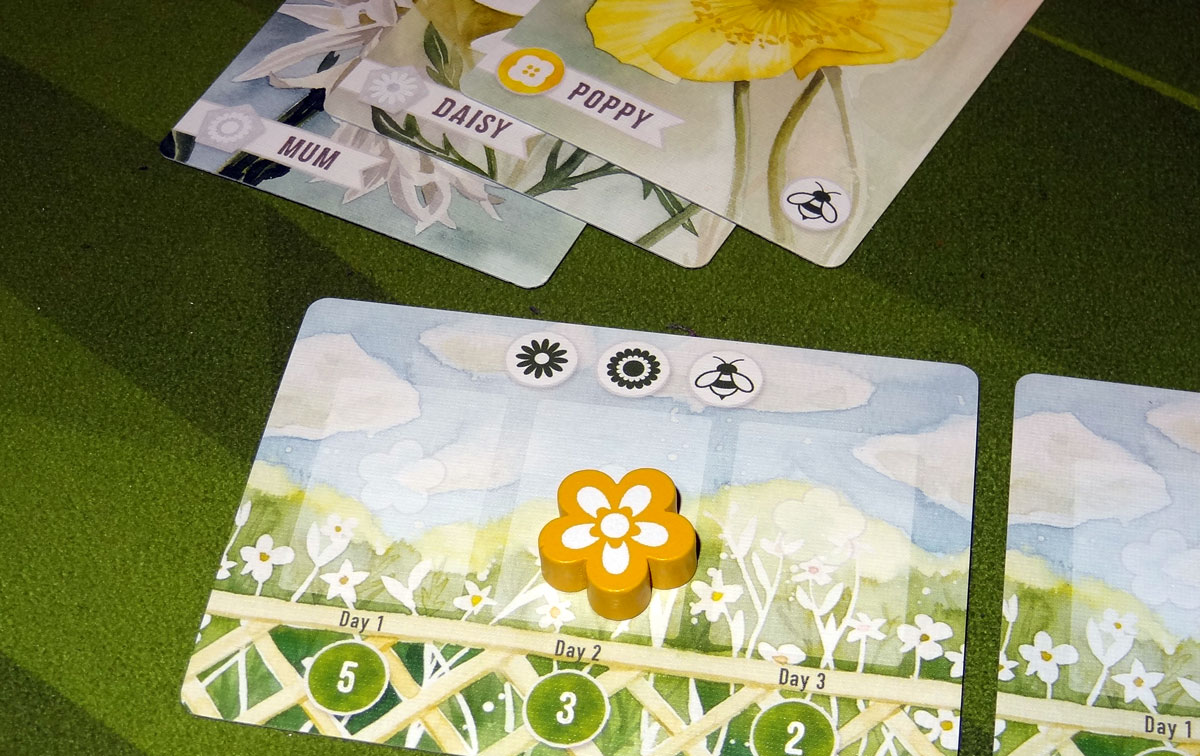
At the end of the day, each player checks their cards to see if they have collected cards that fulfill the bounty cards. Each bounty shows three requirements (flowers or insects)—if you have three cards that match a bounty, then you may place your flower token on the section corresponding to the current day. The sooner you complete bounty cards, the more points you’ll score. Note that you must use three different cards to score a bounty—in the example pictured above, a player could not use a daisy with a bumblebee to meet both requirements. (However, a flower card may be used toward a requirement on more than one bounty card.)
At the end of the first day, discard any remaining cards and lay out another set of cards as on the first day, but this time to the left of the pawns, and players will move through the garden from right to left, keeping the pawn order from the end of the day. For the third day, players will move from left to right again.
Game End
The game ends at the end of the third day. Players will score for bounty cards, desires, arrangements, sculptures, stones, and the cup of tea.
Bounty cards are worth points based on which day you completed them.

Desire cards (picked up during the game) have scoring instructions on them, such as 2 points per poppy or 3 points per ladybug. There are some that will score points based on how many of the same color flower you collected, how many different insects, and so on. Each player scores only the desire cards they collected themselves.

Each arrangement card shows a flower type, color, and an insect. If you meet 1 to 3 of these requirements with your flower cards, you score 1 to 5 points for the arrangement. Unlike the bounty cards, a single flower card may meet multiple requirements for an arrangement. (For instance, a red poppy could fulfill two of the requirements on the leftmost arrangement pictured above.)

The player with the most sculpture cards scores 5 points, second most scores 3 points, and third most scores 1 point. In case of a tie, tied players all score the full amount, but you must have at least one sculpture card to score anything.
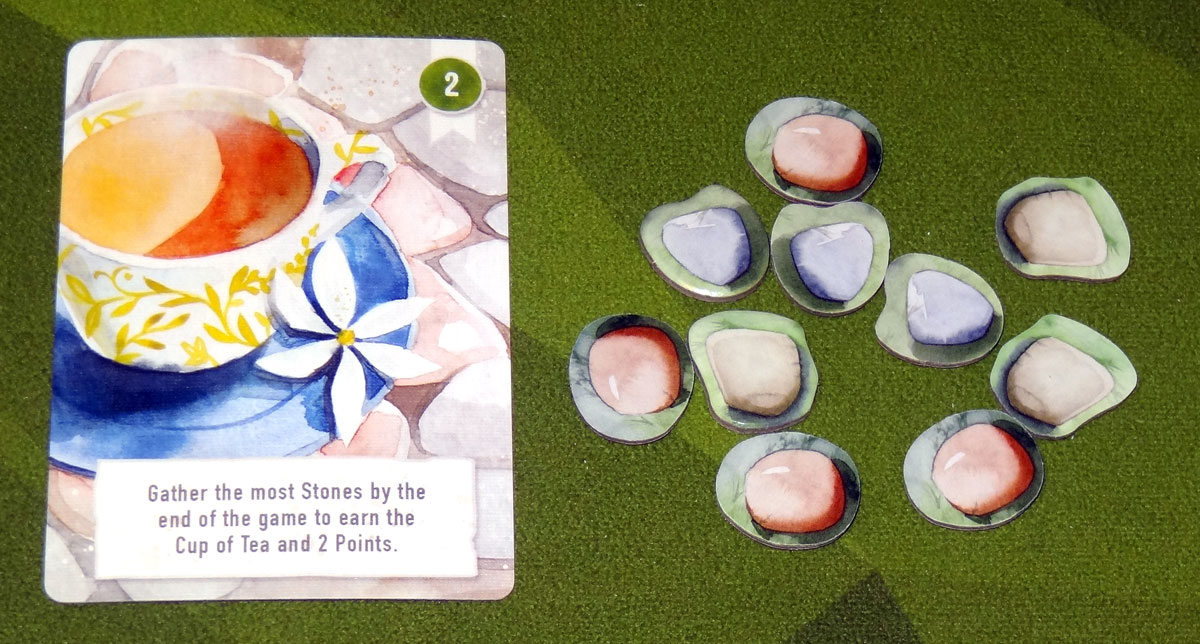
Each pair of stones is worth 1 point, and the player with the most stones gets the cup of tea, worth 2 points. In case of a tie, the player whose pawn is lower in turn order at the end of the game gets the tea. How does having rocks get you a cup of tea? I have no idea, really—but I suppose it’s like the herb biscuit in Herbaceous.
Add up your scores—the highest score wins, with ties going to the player nearest the top of the turn order at the end of the game.

Solo Play: The Pesky Guest
For the solo game, you set up as in a 2-player game, but removing the sculpture cards from the deck and only using your player pawn.
Set the crow card nearby, and shuffle the crow action cards. Place the cup of tea near you.
You take the first turn, and the crow takes a turn after you.

On the crow’s turn, flip over the next crow action card. It will show which of the three cards to remove from the next column. (If it has a stone, it’s removed and put back in the supply.) Then, the card will be replaced either with a face-down card from the deck or with 1 or 2 stones. If you run out of crow action cards, shuffle the cards to form a new deck.
When you take your next turn, you may move to a space where the crow placed stones to discard those stones. Otherwise, you take your turn as normal.
At the end of the day, after scoring bounty cards, resolve the crow card. Place any remaining stones that the crow dropped onto the crow card. You may discard stones you’ve collected to discard stones from the crow card. Then, if the crow card has at least 4 stones on it, discard all the stones and discard one card from your tableau (either a garden card or a desire card). If the crow card has fewer stones on it, leave them there for the next day.
Once during the game, you may discard the tea to skip the crow’s turn, but you score 2 points if you still have the tea at the end of the game.
Score the game as normal, and compare it to your chart to see how relaxed your mood is.
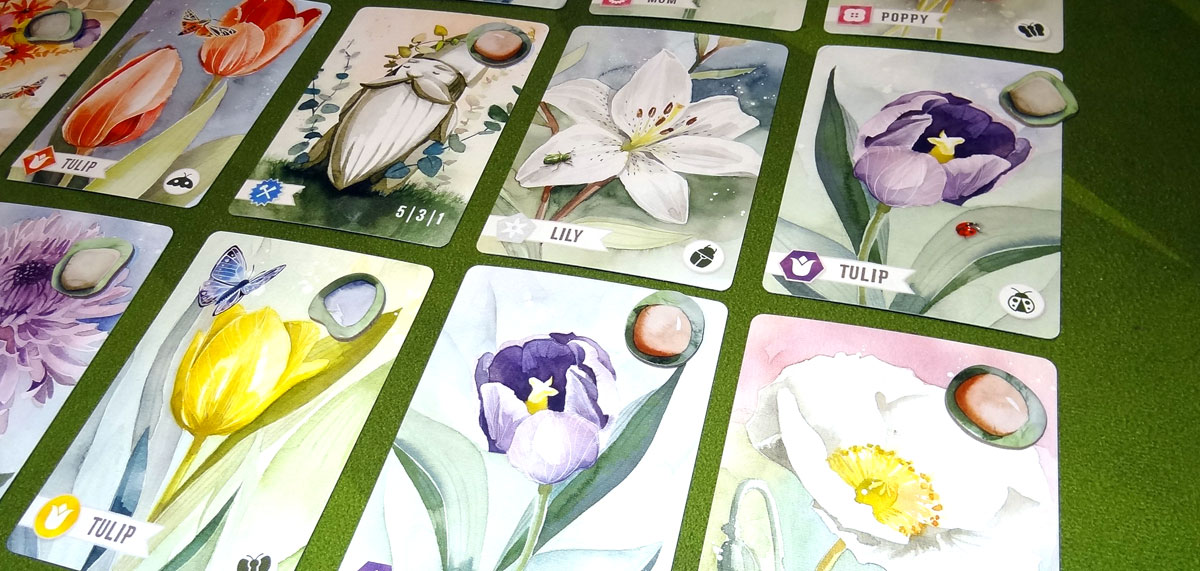
Why You Should Play Floriferous
I’ve been a fan of these collaborations between Steven Finn and Pencil First Games; Steve Finn designs a lot of games for casual players and has released them through a variety of publishers (many through his own company, Dr. Finn’s Games), and Pencil First has done a great job wrapping those games in beautiful artwork and excellent components. Now, the team behind Herbaceous has another lovely game for you: one that soothes your soul with Clémentine Campardou’s beautiful floral illustrations but then turns out to be surprisingly cutthroat.
Floriferous is a great casual game in that it’s easy to learn, pretty quick to set up, and the play time actually seems to match the 20 minutes listed on the box. (I’ll note that the one thing I kept forgetting to do when I played the physical prototype was placing the stones on the specified cards, so make sure you do that. The Tabletop Simulator module took care of it for me.) Your turn? Take a card, move your pawn. That’s it. Simple.
The scoring, for the most part, is also easy to understand. If you take a desire card that says you get 2 points per purple flower, then you know exactly what that means. The bounty and arrangement cards are slightly more complicated, but even then it’s pretty self-explanatory: you want one of each icon shown on the card.
But just because it’s simple to learn doesn’t mean it’s simple to figure out your strategy. Floriferous has plenty of tough choices for you to make each turn. For instance: it always seems inevitable that the desire card ends up in the same column as some flowers that match it. Three points per bumblebee sounds great! But if you take it, you can’t get that card in the same column that has a bumblebee on it. Also, since the desire cards are at the bottom of the column, taking one means you’re going last the next round—if you take a card that gives you points per lily, you can almost guarantee that nobody will leave any lilies for you in the next column. Whether you take an arrangement card or a desire card, that’s one fewer garden cards you can take to fulfill the scoring requirements.
The bounty cards are all known right from the start, and since they’re free for everyone to score, that means everyone is competing for those particular icons. The biggest score boost is finishing bounty cards on the first day (when they’re worth 5 points each), but sometimes sometimes it can look impossible, just based on what cards were dealt out. Of course, there’s always a chance that the face-down cards might include something you need for a bounty, but is it worth taking the mystery card? Or sticking with a known value?
The stones tend to be on the lower rows, so that’s a nice balancing effect: you’ll go later in turn order, but at least you’re scoring half a point for the stone, plus a potential 2 points for the cup of tea. It’s not a huge factor, but a couple of points is nothing to sniff at. Since you can see 5 columns at a time, sometimes you take a card you don’t really need just to make sure you get an earlier turn for the next round.

I was loaned a copy of the prototype for this review, plus I was able to try out the Tabletop Simulator module, and so far between the two I’ve played the game 10 times, with a mix of player counts. The Tabletop Simulator module is scripted so there are buttons to push to set up each day or to manage the crow in the solo game, which makes it even easier to learn. It’s been a lot of fun introducing the game to different people, from my 7-year-old daughter to adults I’d just met at the recent Virtual Game Summit.
I’ve mentioned in previous reviews that I’m generally not as keen on solo games, but as they say, “When in Rome (or in lockdown)…” The Pesky Guest solo mode is absolutely delightful—and by “delightful” I mean “guaranteed to make you want to throw a cup of tea at the crow.” Seriously, this crow is a jerk! Here I am, just making my way through the garden so I can assemble a nice floral arrangement, and this crow is flying ahead, snatching away flowers and overturning things, and dropping rocks on my head. Pesky guest, indeed!
Or… maybe I’m the pesky guest, intruding on the crow’s domain?
At any rate, the solo game is really well done—it feels similar to the 2-player game, though for most of the turns it feels like you’re second in turn order because the crow has removed cards, and it does give you the sense that there’s this annoying crow meddling with your plans. On the other hand, it often replaces them with face-down cards, so you have some room to gamble on the unknown. The stones that the crow drops are a tricky factor—do you get rid of them so you don’t lose a card at the end of the day? Do you try to collect your own stones to cancel them out? Or do you just make sure you have at least one card that you don’t mind losing?
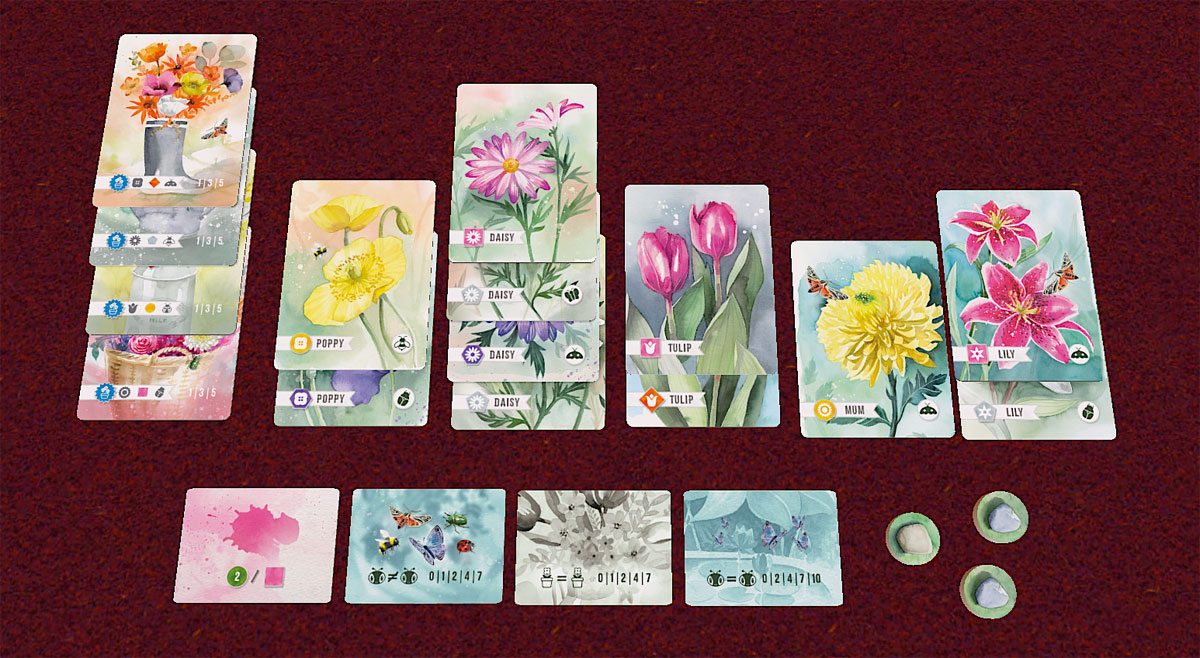
As I said earlier, the game can be quite cutthroat, though that will depend on your players and how much they pay attention to what everyone else is collecting. Since everything you collect is public knowledge, it can become pretty obvious what cards will benefit which players, and that can play into your decision. If you see somebody with a 3 points per moth card, maybe you don’t want to leave a lot of moth cards available to them. Or if somebody is one card away from completing a bounty, perhaps you can delay them to the next day so they don’t score quite as many points. Even when played a little more casually, it’s likely that you’ll pick up some cards that somebody else wanted, even if unintentionally, simply because there are so many overlapping goals.
Floriferous has a similar flavor to Herbaceous, with the gardening theme, lovely artwork, and set-collection scoring, but with a new spin. One difference is that here you are collecting scoring conditions in addition to the cards that fulfill them, so each player will be scoring for different criteria. That’s a small tweak that adds a lot to how you think about the game, and I like it. If you’re already a fan of Pencil First and Steven Finn, this one’s an easy pick! For those who are new to the line, there are also options in the Kickstarter campaign to pick up Herbaceous and Sunset Over Water as well.
For more information or to make a pledge, visit the Floriferous Kickstarter page!
Click here to see all our tabletop game reviews.
![]() To subscribe to GeekDad’s tabletop gaming coverage, please copy this link and add it to your RSS reader.
To subscribe to GeekDad’s tabletop gaming coverage, please copy this link and add it to your RSS reader.
Disclosure: GeekDad was loaned a prototype of this game for review purposes.





